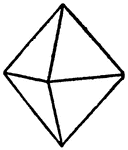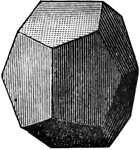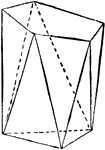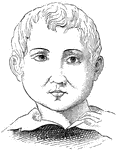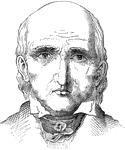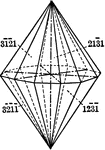
Dihexagonal pyramid
"The dihexagonal pyramid is a form of twenty-four isoceles triangular faces, each of which intersects…

Apatite
"A complex crystal of apatite with the faces of a third-order pyramid upon it." — Ford, 1912
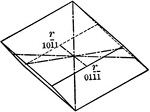
Positive rhombohedron
"The rhombohedron is a form consists of six rhombic-shaped faces, which correspond in their position…
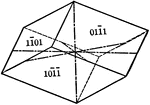
Negative rhombohedron
"The rhombohedron is a form consists of six rhombic-shaped faces, which correspond in their position…

Scalenohedron
"This form consists of twelve scalene triangular faces. These faces correspond in their position to…

Tourmaline
"Tourmaline crystals show the forms of the Rhombohedral Class but with hemispherical development. They…
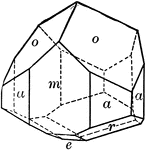
Tourmaline
"Tourmaline crystals show the forms of the Rhombohedral Class but with hemispherical development. They…

Tourmaline
"Tourmaline crystals show the forms of the Rhombohedral Class but with hemispherical development. They…

Right-handed quartz
"The quartz crystals are said to be right or left handed, depending upon whether these faces are to…

Left-handed quartz
"The quartz crystals are said to be right or left handed, depending upon whether these faces are to…
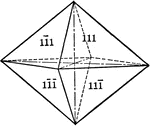
Pyramid
"An orthorhombic pyramid has eight triangular faces, each of which intersects all three of the crystallographic…
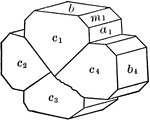
Bournonite
"Orthohombric. Crystals usually short prismatic to tabular. Sometimes quite complex with many prism,…
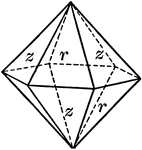
Quartz
"Terminated usually by a combination of a positive and negative rhombohedron, which often are so equally…

Dolomite
"Hexagonal-rhombohedral. Crystals are usually the unit rhombohedron (cleavage rhombohedron). Faces often…

Aragonite
"Orthorhombic. Tabular; consisting of prominent brachypinacoid faces modified by a prism and a low brachydome."…

Amphibole
"Monoclinic. Crystals prismatic in habit; the prism faces make angles of 55 and 125 degrees with each…
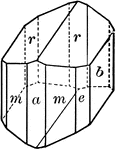
Amphibole
"Monoclinic. Crystals prismatic in habit; the prism faces make angles of 55 and 125 degrees with each…
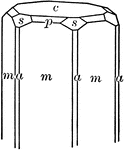
Beryl
"Hexagonal. Strong prismatic habit. Frequently vertically striated and grooved. Forms usually present…

Wernerite
"Tetragonal; tripyramidal. Crystals usually prismatic. Prominent forms are prisms of the first and second…

Epidote
"Monoclinic. Crystals are often much elongated parallel to the ortho-axis with a prominent development…

Calamine
"Orthohombic, hemimorphic. Crystals usually tabular parallel to the brachypinacoid. They show prism…
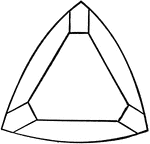
Tourmaline
"Hexagonal-rhombohedral; hemimorphic. Crystals usually prismatic, vertically striated. A triangular…

Tourmaline
"Hexagonal-rhombohedral; hemimorphic. Crystals usually prismatic, vertically striated. A triangular…
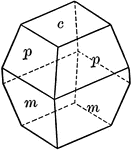
Titanite
"Monoclinic. Crystals varied in habit. Often with prominent basal plane which is steeply inclined and…

Titanite
"Monoclinic. Crystals varied in habit. Often with prominent basal plane which is steeply inclined and…

Barite
"Orthohombic. Crystals usually tabular parallel to base; often diamond shaped because of the presence…
Barite
"Orthohombic. Crystals usually tabular parallel to base; often diamond shaped because of the presence…
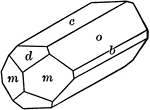
Celestite
"Orthorhombic. Crystals resemble closely those of barite. Commonly tabular parallel to the base or prismatic…
Gypsum
"Monoclinic. Crystals usually tabular parallel to clinopinacoid; in diamond-shaped crystals with edges…
Gypsum
"Monoclinic. Crystals usually tabular parallel to clinopinacoid; in diamond-shaped crystals with edges…
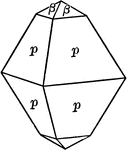
Scheelite
"Tetragonal; tri-pyramidal. Crystals usually simple pyramids of first order. Closely resemble isometric…
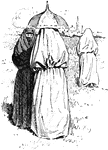
Turkish women
"These are two Turkish women, who have their heads and faces wrapped up." —Carpenter, 1902
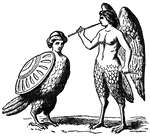
Harpies
"These were disgusting birds, with the heads of maidens, with long claws and faces pale with hunger.…

Modern house
"A modern small house with the 'lean-to' motif. Notice that the long slope faces the front." —Kinne,…
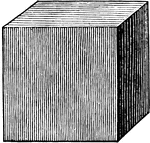
Cube
A regular body with six square faces; a rectangular parallelopiped, having all its edges equal.
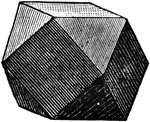
Cuboctahedron
A solid with fourteen faces formed by cutting off the corners of a cube parallel to the coxial octahedron…
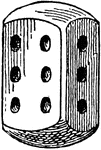
Roman Die
A small cubed marked on its faces with spots numbering from one to six, used in gaming from being thrown…
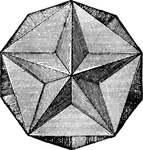
Great Dodecahedron
A regular solid each face of which has the same boundaries as five covertical faces of an ordinary icosahedron.

Rhombic Dodecahedron
A solid consisting of 12 similiar faces, each of which is rhomb, the angle between any two adjacent…
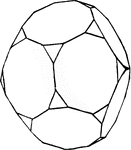
Truncated Dodecahedron
A regular dyocaetriacontahedron formed by cutting off the faces of a regular dodecahedron parallel to…

Crown-Work
"Crown-work, in Fortification, is formed to strengthen a weak front, or to occupy ground which might…
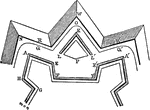
Curtain
"Curtain, in Fortification, is the portion of rampart or wall between two bastions or two gates. In…

Camera Lucida
"An optical instrument employed to facilitate the sketching of objects from nature by producing a reflected…

Revolving Light
"If again the light was to revolve, then a revolving chandelier was employed having a certain number…
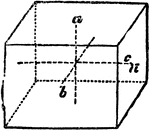
Primitive Crystal
"When the base is a rhomboid, and the prism stands erect, it is only the opposite laeral faces that…

Angular Perspective
This object is a cube, having therefore all its faces of equal dimensions; and as both sides recede,…
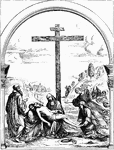
Deposition from the Cross
This painting, by Francesco Raibolini, was painted soon after 1500 for the Benedictines of Parma. The…
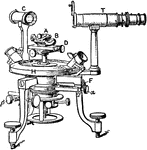
Horizontal-Circle Goniometer
The goniometer is an instrument for measuring the angles of crystals. Nicolaus Stena in 1669 determined…

Vertical Circle Goniometer
The goniometer is an instrument for measuring the angles of crystals. Nicolaus Stena in 1669 determined…
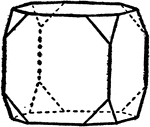
Cube in Combination with Octahedron
Represents the combination of an octrahedron and a cube, with the cube faces predominate.


